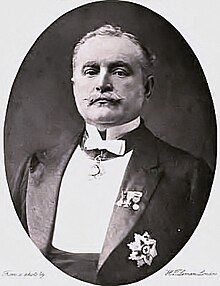Richard Caton Woodville, Jr.
| Richard Caton Woodville | |
|---|---|
 |
|
| Born |
7 January 1856 London |
| Died | 17 August 1927 (aged 71) London |
| Nationality | British |
| Education | Düsseldorf school of painting |
| Known for | portrait, landscape, illustration, battle painting |
| Patron(s) | Illustrated London News |
Richard Caton Woodville (7 January 1856 – 17 August 1927) was an English artist and illustrator, who is best known for being one of the most prolific and effective painters of battle scenes in the late 19th and early 20th centuries.
The son of Richard Caton Woodville, Sr., who was also a talented artist, Woodville studied at the Düsseldorf school of painting under the Prussian military artist Wilhelm Camphausen, and then Eduard von Gebhardt, before briefly studying in Russia and then Paris under Jean-Léon Gérôme. Woodville spent most of his career working for the Illustrated London News, where he quickly developed a reputation as a talented reporter and writer, but was also published in Cornhill Magazine, Strand Magazine, and The Tatler.
Richard Caton Woodville first experienced battle first-hand when he was sent by the Illustrated London News to report upon the Russo-Turkish War (1877–1878), and then again in the 1882 Anglo-Egyptian War, where he made numerous sketches in December 1882, and also obtained photographs of the trenches at Tel-e-Kebir for his friend and co-artist Alphonse-Marie-Adolphe de Neuville, who had been commissioned to paint a scene of the battle.
In 1879, Woodville's Before Leuthen, 3 Dec 1757 was exhibited in the Royal Academy. It proved popular, and afterwards he began to regularly be exhibited in Burlington House, where 21 of his battle paintings were eventually shown. His most popular works there were ones that dealt with contemporary wars, such as the Second Anglo-Afghan War, Candahar [sic], and Maiwand: Saving the Guns, (Walker Art Gallery), the Zulu War, and the First Boer War. His works from Egypt were exhibited at the Fine Art Society in 1883, where his painting The Moonlight Charge at Kassassin proved very popular. The following year he exhibited by Royal Command another painting he had done of the war in Egypt, entitled The Guards at Tel-e-Kebir (Royal Collection).
...
Wikipedia
